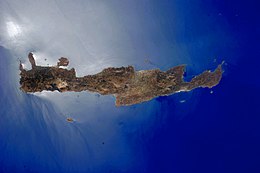Native name: Κρήτη | |
|---|---|
 NASA photograph of Crete | |
 | |
| Geography | |
| Location | Eastern Mediterranean |
| Coordinates | 35°12.6′N 24°54.6′E / 35.2100°N 24.9100°E |
| Area | 8,450 km2 (3,260 sq mi) |
| Area rank | 88 |
| Highest elevation | 2,456 m (8058 ft) |
| Highest point | Mount Ida (Psiloritis) |
| Administration | |
| Region | Crete |
| Capital city | Heraklion |
| Largest settlement | Heraklion (pop. 144,442[1]) |
| Demographics | |
| Demonym | Cretan, archaic Cretian |
| Population | 624,408 (2021)[2] |
| Population rank | 73 |
| Pop. density | 74.9/km2 (194/sq mi) |
| Ethnic groups | Greeks; historically, Minoans, Eteocretans, Cydonians and Pelasgians |
| Additional information | |
| Time zone |
|
| ISO code | GR-M |
| HDI (2022) 0.911[3] very high · 3rd of 13 | |
Crete (/kriːt/ KREET; Greek: Κρήτη, Modern: Kríti [ˈkriti], Ancient: Krḗtē [krɛ̌ːtεː]) is the largest and most populous of the Greek islands, the 88th largest island in the world and the fifth largest island in the Mediterranean Sea, after Sicily, Sardinia, Cyprus, and Corsica. Crete is located about 100 km (62 mi) south of the Peloponnese, and about 300 km (190 mi) southwest of Anatolia. Crete has an area of 8,450 km2 (3,260 sq mi) and a coastline of 1,046 km (650 mi). It bounds the southern border of the Aegean Sea, with the Sea of Crete (or North Cretan Sea) to the north and the Libyan Sea (or South Cretan Sea) to the south. Crete covers 260 km from west to east but is narrow from north to south, spanning three longitudes but only half a latitude.
Crete and a number of islands and islets that surround it constitute the Region of Crete (Greek: Περιφέρεια Κρήτης), which is the southernmost of the 13 top-level administrative units of Greece, and the fifth most populous of Greece's regions. Its capital and largest city is Heraklion, on the north shore of the island. As of 2021[update], the region had a population of 624,408.[4] The Dodecanese are located to the northeast of Crete, while the Cyclades are situated to the north, separated by the Sea of Crete. The Peloponnese is to the region's northwest.
Crete was the center of Europe's first advanced civilization, the Minoans, from 2700 to 1420 BC. The Minoan civilization was overrun by the Mycenaean civilization from mainland Greece. Crete was later ruled by Rome, then successively by the Byzantine Empire, Andalusian Arabs, the Venetian Republic, and the Ottoman Empire. In 1898 Crete, whose people had for some time wanted to join the Greek state, achieved independence from the Ottomans, formally becoming the Cretan State. Crete became part of Greece in December 1913.
The island is mostly mountainous, and its character is defined by a high mountain range crossing from west to east. It includes Crete's highest point, Mount Ida, and the range of the White Mountains (Lefka Ori) with 30 summits above 2,000 metres (6,600 ft) in altitude and the Samaria Gorge, a World Biosphere Reserve. Crete forms a significant part of the economy and cultural heritage of Greece, while retaining its own local cultural traits (such as its own poetry and music). The Nikos Kazantzakis airport at Heraklion and the Daskalogiannis airport at Chania serve international travelers. The Minoan palace at Knossos is also located in Heraklion.[5]
- ^ "CensusHub2". ec.europa.eu. Retrieved 22 March 2021.
- ^ "Census 2021 GR" (PDF) (Press release). Hellenic Statistical Authority. 19 July 2022. Archived (PDF) from the original on 19 July 2022. Retrieved 12 September 2022.
- ^ "Sub-national HDI – Area Database – Global Data Lab". hdi.globaldatalab.org. Retrieved 20 July 2021.
- ^ "Population on 1 January by NUTS 2 region". Statistics Eurostat. Archived from the original on 21 January 2021.
- ^ Ancient Crete Archived 30 May 2020 at the Wayback Machine Oxford Bibliographies Online: Classics